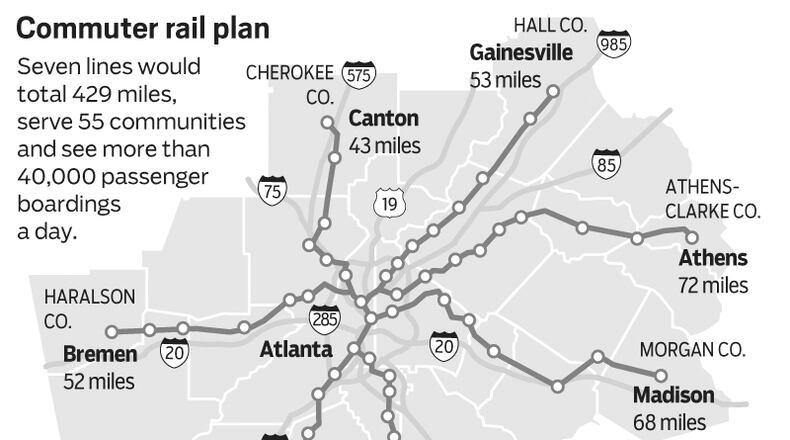Nine months after the T-SPLOST’s defeat, the Atlanta region is still grappling for a doable “Plan B” to begin reducing the traffic congestion that affects us all. Some counties are starting to talk about ways to work together on smaller-scale transportation improvements. Meanwhile, voters remain leery of big, costly solutions, yet indicate a willingness to pay for solutions they think will work.
It’s imperative that civic debate continue around congestion relief strategies. One idea that should remain in the conversation has been embraced in most other Atlanta-class cities: commuter rail. It’s a concept that’s long been on public planners’ radar here. Yet the idea vanished from public discussion several years ago, apparently being short of both political backing and actual funding.
As this metro area looks toward future solutions, the concept deserves continued exploration. This is not to say commuter rail is the magic fix for all of the region’s traffic woes; but we ought to at least consider it for our toolbox.
What is commuter rail? It’s not MARTA, nor is it light rail; it’s conventional passenger trains, pulled by diesel locomotives, operating on existing railroads. Commuter trains are familiar in older cities like New York, Chicago and Philadelphia; and becoming increasingly so in places that have introduced them in recent years, like Nashville, Minneapolis and Dallas-Ft. Worth.
“Of the nation’s 13 most populous metropolitan statistical areas (Atlanta is the ninth), 10 have a commuter rail system,” according to the introduction to the 2007 R.L. Banks and Associates study for the Metro Atlanta Chamber, Georgia Department of Transportation and Transit Planning Board.
The broad commuter rail plan here envisioned seven commuter lines totaling 429 miles, serving 55 communities and projected more than 40,000 passenger boardings a day (see map).
That works out to about 20,000 people a day. The Georgia Regional Transportation Authority’s Xpress commuter bus system, by comparison, carries 9,000 daily riders on 33 routes and is touted for removing many drivers from area roads.
The commuter rail plan estimated capital cost for rolling stock and line improvements would be upwards of $2 billion in 2007 dollars – unadjusted for inflation, granted, but still less than a third of what the T-SPLOST would have cost. Commuter rail is cheaper than constructing new, dedicated, MARTA-like lines because it uses existing infrastructure.
Even if the idea caught on here, it’s unlikely the entire rail system would be built at once. Service could begin on a single route to test the concept. If that line proved successful, trains could roll out on others as funding and local public support warranted. That’s the approach that surfaced here two years ago. During the T-SPLOST debate, state Rep. Ed Setzler, R-Acworth, backed a 30-mile commuter rail line from Atlanta to Acworth that he estimated could be started for “considerably less than $100 million,” compared with $856 million for a proposed 8-mile light-rail line from Midtown to Cumberland Mall.
Even given today’s tax-leery political landscape, the public may now be more receptive. A recent poll commissioned by The Atlanta Journal-Constitution found nearly two-thirds of respondents were willing to pay a new fee or tax to create well-designed public transit, and more than two-thirds in Cobb and Gwinnett counties supported expanding train service beyond Fulton and DeKalb counties.
Certainly, if they’re willing to consider allowing commuter trains, the region’s major freight railroads, CSX Transportation and Norfolk Southern, would need to be compensated for track and signal improvements. The upside for them would be enhanced capacity for freight trains, a pressing need today that’s expected to become even more so as traffic builds at the Port of Savannah and needs to move across the country.
It should go without saying that if commuter rail is to have a chance, support must start with citizens and work upwards through their mayors, county commissioners and business chambers. The process should be deliberate, inclusive and yes, conservative: one city and one county at a time. That’s a lesson T-SPLOST taught us.
Commuter rail may hold promise in bridging the distance between in-city transit systems like MARTA and our far-flung suburbs. If the Atlanta region still has aspirations of being a global 21st-century city, we may want to include commuter rail in the discussion about our transportation future. Many of our competitors are already there.
David Ibata, for the Editorial Board.
About the Author
Featured

